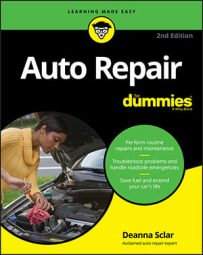Cleaning your car efficiently saves you time and effort and ensures that the vehicle’s body comes out looking great. If you clean haphazardly, the task takes much longer, and you run the risk of scratching the finish, streaking the surface, and leaving the body vulnerable to rust.
Most modern vehicles are painted in a two-step process that produces a clear-coat finish, which can far outlast the acrylic lacquer or enamel used on older vehicles. Although a clear-coat finish protects and enhances the paint, it’s sensitive to abrasion and chemicals. If it wears away, the paint beneath it will deteriorate rapidly.
To wash your car efficiently, follow these guidelines:-
Never wipe or dust the body with a dry cloth: The tiny particles of dust and grit on the surface can scratch the paint.
-
Never wash a vehicle in the hot sun: The cool water causes the hot body to contract, which can crack the paint and ruin the finish.
-
Be sure the windows and sunroof are closed before washing: Spray lightly around the edges of the windows, sunroof, and rear deck lid for a short time and then check to see if the weatherstripping leaks.
-
Before you wash the car, hose it down to get rid of the surface dust: Then clean and polish such exterior surfaces as vinyl hardtops, convertible tops, glass windows and sunroofs, chrome bumpers and trim, side mirrors, wheel covers, whitewalls, and tires.
-
Use cold or lukewarm water and a hose rather than a bucket of water to wet and rinse the car: A bucket holds a finite amount of water. As you rinse out your rag or sponge, the dirt is transferred to the water and back to the rag.
-
Use a sponge, soft rag (old terrycloth towels, T-shirts, or cotton diapers are wonderful), or a cotton wash mit: Cotton swabs and an old toothbrush will help you get into small areas.
-
To avoid cobwebby scratches, follow the contours of the surface rather than going in circles: Rinse the rag often to get rid of grease and dust particles. Be thorough but gentle; vigorous scrubbing can scratch and remove the paint.
-
Use gentle cleansers: Use a commercial car-washing product, not laundry or dish soap or detergent, which can remove the wax and other protective finishes from the surface.
Use biodegradable cleaning products to minimize environmental pollution. Try to do the job on a grassy or graveled area where the water can be absorbed and filtered by the dirt below, or do your washing near a drain. Do not let the water run down the street and into a storm drain.
Every job goes more smoothly and efficiently if the work you do is organized properly. The following tips help you wash your vehicle in an order that will get you the best results:-
Always wash the body of a vehicle from the top down: That way soap scum and sludge don’t muck up freshly washed areas.
-
Remember to get to all the corners where dirt can collect and rust can form: Don’t forget the underbody.
-
Wash one section of the vehicle at a time: Hose it down, soap it up, and rinse it off. When you finish the entire vehicle, hose it all down again.
-
Towel-dry the car with terry towels, cotton diapers, or a synthetic chamois to get rid of water spotting that can mar the surface: Chamois are good for this purpose and can be washed, rinsed, and used for years. But they’re more expensive.
-
At regular intervals, apply a coat of wax or sealer: A high-quality polymer sealant provides the best protection because it binds with the paint.

